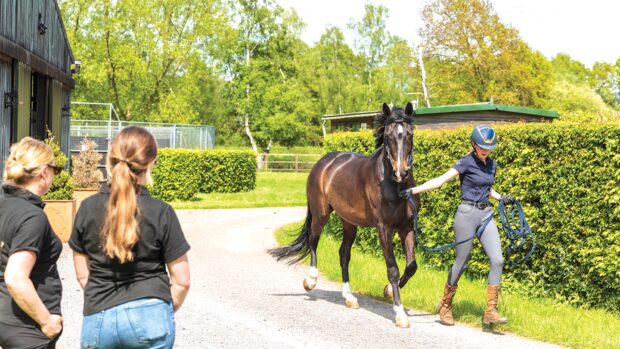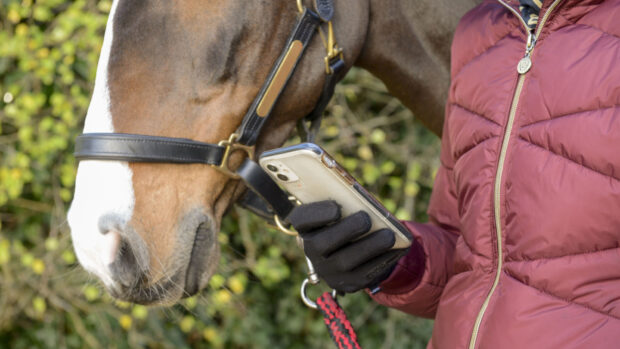Part two: tips for choosing horses for view
You’ve trawled the horses for sale adverts, found a horse that sounds like it could be suitable, spoken to the seller and seen videos of the horse in action, so now it’s time to go and try it. Although this is an exciting experience, it can be really nerve-wracking too. To make sure you get the most out of your viewing and don’t waste anyone’s time, go with a clear plan and expectations in your head.
Try to take your trainer, or someone with good equestrian knowledge who you trust with you. Use your smart phone (or a video camera) to film everything from the trot-up to both the seller and yourself riding the horse. Getting an expert’s opinion on whether the horse is suitable for you can save an expensive mistake. If you can’t organise someone to go with you on the visit, going home and showing them the video of the horse can be almost as helpful. It can also be useful to show the footage to your vet if you have any soundness concerns. And, don’t forget to refer back to your original checklist!
Here are a few points to help you out when you get there:
- Remember that first impressions count, so trust yours (that counts for your first impression of the seller, as well as the horse).
- When you arrive on the yard, take a look around the horse’s stable for any signs of stable vices, for example a chewed door or a weave grill.
- Ask to see the horse trotted up so that you can assess his conformation and soundness. It is also worth taking a good look at his feet to see how he is shod and whether he has good, strong feet.
- Ask to prepare him for the ride yourself, as it’ll give you some time to assess his manners and get a general impression from him. In most cases, the horse will be turned out beautifully in anticipation for your arrival, but do everything as you would normally; pick out his feet, lightly brush him over and tack him up.
- Look for clues that he has been worked prior to your arrival, such as sweat marks. A lack of water in his box should ring alarm bells.
- Remember simple things like good manners and a willing temperament will really matter if you were to buy him.
- Make sure someone else rides the horse first — usually a brief 10 to 15 minutes showing walk, trot, canter and a few jumps will suffice before you have a go. If they don’t have anyone available, think carefully before getting on board!
- Remember to video — it’ll allow you to look back a bit more objectively when you get home. Plus, if you’re trying out a few horses close together this will help you recall each one better.
- Remember that temperament is often more important than type. There’s every possibility that you’ll end up buying a horse that isn’t the one you dreamed of — but ultimately, that doesn’t matter. If you have a connection and he has the right temperament and skills that suit your needs, then that’s more important than what he looks like.
- Be aware that the seller should be asking you lots of questions too. If they are genuine then they will want to make sure that you are the perfect new partner for the horse, so take a disinterested seller as a warning sign.
If at any time during the viewing you decide the horse is not what you are looking for, then rather than wasting your or the seller’s time, you can simply stop and say “thank you for your time, but the horse isn’t for us”. In particular, if you don’t feel confident about riding the horse, do not feel obliged to get on board. There is a risk involved in riding horses that are not known to you, so you might want to ensure you have personal accident cover in place, just in case, but check the small print to ensure you’re covered in this situation.
If the initial viewing has gone well, we would recommend you view the horse more than once, if this is possible. If you do return for a second or third viewing:
- Vary the environments you ride him in to match the circumstances you are likely to find yourself in. For example if you would like to go eventing, ask if you can take him cross-country schooling.
- View him at different times of the day so that you can get a fuller picture of his behaviour.
- Ask to turn him out and catch him to see how he behaves.
- Load him onto a trailer or horsebox, depending on what you have. A horse that is difficult to load can be a real bore.
- If your trainer was unable to come with you for the first viewing, see if they can attend this time.
Once you’ve finished the viewing, thank the seller for their time and go home to mull over whether you think the horse might be the right one for you. It’s not unusual for a seller to encourage a buyer to commit to buy the horse at the end of the viewing, but, particularly if you are an inexperienced buyer, H&H recommends not being swayed by these tactics, although this may put you at risk of the horse being sold to another person while you make your decision.
If you are confident that the horse is suitable for you and wish the seller not to show the horse to other potential buyers, then it is reasonable for the buyer to ask you to put a deposit down at this stage, while you arrange for the horse to be vetted. In these circumstances, get an agreement in writing that you have first refusal on the horse, that it will not be shown to/sold to any other potential buyers, and under what circumstances the deposit will be refunded – if you have the horse vetted and then decide not to proceed with the sale based on the results, will the deposit be returned? This helps avoid any conflict at a later date if the sale does not proceed as expected.
If, after consideration, you decide the horse is not for you, it is good manners to contact the seller to let them know so they aren’t left hanging. You don’t need to explain why – a simple “thank you for showing the horse to us, but we’ve decided he/she isn’t for us” will suffice.
Next step: Important dos and don’ts when buying a horse
Ultimate guide to buying a horse
Buying a horse: Horse & Hound’s ultimate step-by-step guide
Buying a horse: choosing horses to view
Buying a horse: important dos and don’ts
Buying a horse: the vetting or pre-purchase examination
Buying a horse: final questions, payment and when you get your new horse home
Make sure you set aside plenty of time enjoy the journey of finding your perfect equine partner, as it could easily last a few months, but it will be worth it in the end.




